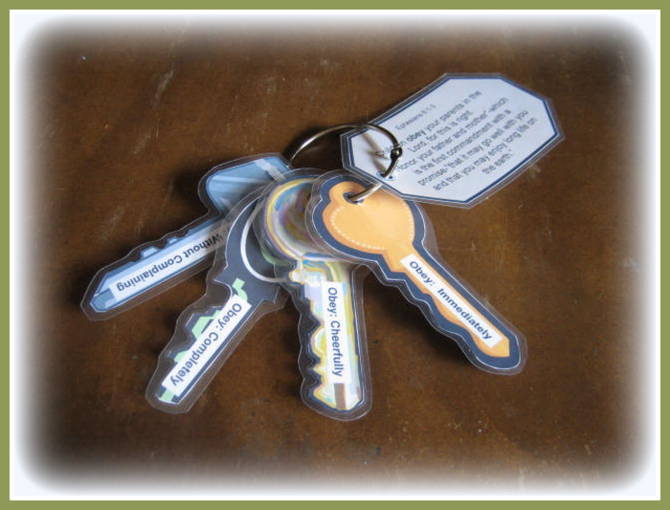Obedience: The Formula for Fall Blessings, Pt. 3

Obedience can be a difficult behavior to instill in children. But guest blogger Amy Stout’s series on the topic can help. In Part 1, she discussed first steps parents need to take so their kids will be inclined to obey. In Part 2, she provided an illustration to use with kids. In the final post in her series on the topic, she shares easy ways for kids to practice obeying their parents.
Obedience: The Formula for Fall Blessings, Pt. 3
Obedience: How to Practice It
Obedience is comprised of listening/processing and following directions. When caregivers say to my child, “Kylie, you need to listen,” it drives me C-R-A-Z-Y. Kylie has auditory processing issues. She HAS listened. The time lapse in response is due to her brain trying to process the information so she can act.
Some children (a LOT of children) require object cues, picture cues, sign language cues, lists, or other things to help them understand what it is that you are asking of them. Otherwise, your directive sounds like that of Charlie Brown’s teacher “wah, wah, wah, wah, wah, wah.” No child has a chance at following that direction.
If it is time for Kylie to pick up toys, we don’t generalize and say, “Kylie you need to pick up toys.” Instead, we use a white board and we write on it:
- Pick up markers
- Pick up Barbies
- Pick up coloring books
Or, we will use a First/Then method and say, “Kylie, first pick up Barbies. Then eat popsicle.” Both strategies allow her some flexibility in making the decision for herself, but both also accomplish the task needing to be completed.
It is also important to give your child the tools and scenarios to be successful. Do not set them up for failure by keeping them up too late at night and demanding obedience when they are too tired to respond appropriately. Don’t attempt a clean-up routine when lunch has been delayed by an hour. All they can think of is how hungry they are. They are in no mindset to be obedient. Make sure your child’s needs are met first and then work on practicing obedience together.
Obedience: Easy Ways to Practice It this Fall
- Follow directions according to a recipe for food or for play dough. If the recipe is not followed correctly, the item does not turn out as it should. Here is my recipe for pumpkin pie scented play dough.
- Do an activity together that encourages following a pattern. Here is a pumpkin nailing activity that we did with Kylie.
- Play a game with 2 step directions. Here is a game that we play with Kylie that not only focuses on following directions, but also on counting and sensory integration.
- Work on boundaries: We do this by creating seasonal sensory bins for Kylie to play in. We put a large sheet under the sensory bin and the rule is that the items in the sensory bin HAVE to stay within the boundary of the sheet. If they end up on the carpet or in another room, we have to put away the sensory bin for a time. Here are links to our Halloween bin, our Icky Sticky bin, and our November/Thanksgiving bin.
Anne Sullivan, Hellen Keller’s teacher, once said, “I have thought about it a great deal, and the more I think, the more certain I am that obedience is the gateway through which knowledge, yes, and love, too, enter the mind of the child.”
What Do You Think?
Thank you, Amy, for these practical ways to practice obedience. Do you have some ideas to add to Amy’s? Leave a comment.
Obedience: The Formula for Fall Blessings, Part 1
Obedience: The Formula for Fall Blessings, Part 2
Do you like what you see at DifferentDream.com? You can receive more great content by subscribing to the quarterly Different Dream newsletter and signing up for the daily RSS feed delivered to your email inbox. You can sign up for the first in the pop-up box and the second at the bottom of this page.

By Amy Stout
Amy Stout is a wife, mother, and free-lance writer. You can visit her website at His Treasured Princess.
4 Comments
Submit a Comment
Subscribe for Updates from Jolene
Related Posts
The Lessons I Learned while Raising a Child with EA/TEF
Jolene Philo reflects on a lifetime of lessons learned while raising a child with EA/TEF and shares the insights she’s won.
Looking Back at Your Child’s EA/TEF Journey
Looking back at your child’s EA/TEF journey can give parents a new perspective about past events. Guest blogger Maggi Gale shares how her look back clearly showed her how God was with their family during their daughter’s very unusual first weeks of life in 2002. Three...
How Do I Let Go of My Adult EA/TEF Child?
Valeria Conshafter explores the question “How do I let go of my adult EA/TEF child?” for EA/TEF Awareness Month.






Keri – That is a GREAT idea, but I’ll warn you, pancakes can be very forgiving. It will probably just make super thin pancakes.. =0)
Bonnie- Thanks for that resource. I have also heard of Picture Maker and several other programs, but the one you mentioned seems very reasonably priced!! Love learning about new products!
How do you kids respond? Do you have a reward system? I’d love to hear more about it.
Thanks for alerting Different Dream readers to this resource, Bonnie. What a boon for parents of kids with strong visual skills and a need to communicate.
I used a product called Visual Essentials by Silver Lining Multimedia. It had Visual charts you could customize for any level of behavior you are trying to incorporate. It costs about $70, has 3500 images on it and well worth it. My daughter is 16 years old and on autism spectrum, I also have a 10 year old son, adopted at 4, who has sever emotional issues which lead to very difficult behavioral issues. I now use this CD with him as well.
Here is a link to the site for the product, if you look around there are samples if I remember correctly. http://www.silverliningmm.com/vessenframe.htm
Great article!
Bonnie Murphy
Thanks for the ideas Amy! I particularly like the one about having them follow a recipe to help you make something, like the playdough. It doesn’t come out right if you don’t follow the directions. Rebecca is all the time wanting to put more water into the pancake batter and I know that it doesn’t need more. It drives me c-r-a-z-y that she has a fit because she wants to help put water in!! I think next time I will purposely let her put in as much water as she wants so she can see what happens when we don’t follow the recipe! Thanks for the idea.